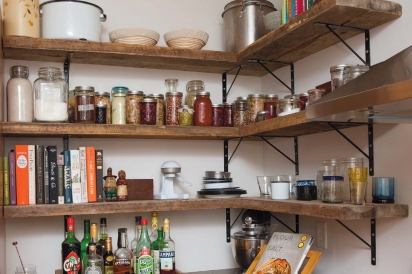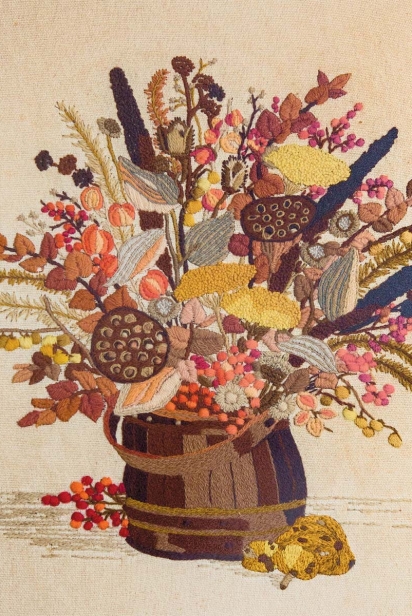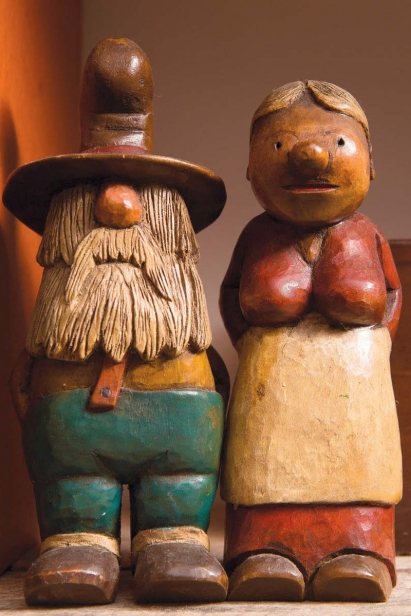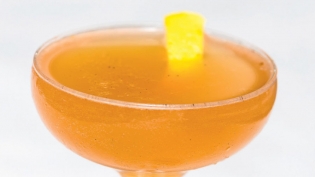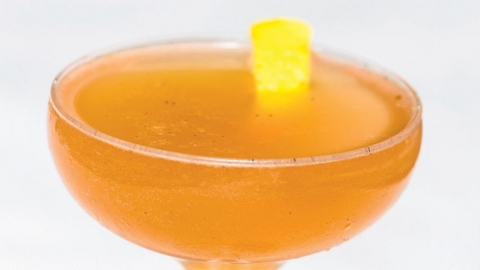Drinking slow with The Farm and The Fisherman’s Danny Childs
The story of a cocktail, and of the ingredients that create its internal harmony, is one of nature and agriculture. Distillation and fermentation stop ingredients in time, the elements of season and place suspended. The spirit captures what the earth provides so that it might be used to heal, to entertain or to console.
Consider amari. Currently enjoying a spotlight moment in the American craft-cocktail scene, these bitter herbal liqueurs boast a long lineage among Italian digestives, with ancient roots that evoke chapters of the spice trade—ingredients moving across coordinates and cultures and then stopped in bittersweet liquid form. Those who respect that history tap into a power that enables them to tell new stories about their own time and region. It’s no surprise, then, that Danny Childs of The Farm and Fisherman Tavern & Market in Cherry Hill found his way to the bar from the field—which in his case, has two meanings.
As a University of Delaware student studying anthropology, pre-med, and Spanish, Childs spent six months examining the ethnobotanical traditions of the Mapuche, Shipibo and Atacameño tribes in Chile and Peru. His guiding question centered on pluralism: how can traditional, plant-based healing practices be maintained in concert with modern medicine? Ultimately, Childs lived in South America for a year and a half, during which time a backpacking journey with his then girlfriend (now wife) Katie sparked curiosity about hyperlocal culinary traditions.
After their return to the United States, the couple worked on local farms, digging into the regionalism of their own back yard. Feel free to read that literally: For nine months, the intrepid pair lived in a 15- by 15-foot military-grade tent on Indian Acres Tree Farm in Medford. Originally, the restaurant gig was a way for Childs to make extra cash. Now, he works closely with chef Todd Fuller and general manager Ben Menk to infuse an increasingly local-centric ethos into the restaurant’s cocktail program, including seasonal amari of their own.
“Danny has natural curiosity,” Fuller says. “He is passionate about what the land has to offer, whether it’s on the farm or in the wild. The amari are the best example. In Italy, there are amari in every town. Why is that? Because they use everything that’s available.”
Pursuit of what the land can teach us energizes Childs. On a given work day, he might be fermenting soda, foraging in the Pine Barrens or pondering the potential of untapped ingredients with Fuller and team. The resulting cocktail menu, which changes on the regular, is classically inspired and thoughtfully creative. It’s cerebral, yet restrained.
The same can be said of Childs’ culinary adventures on days off with Katie, who, as an event stylist for home-and-garden tastemaker Terrain, draws equal inspiration from the “field.” In the kitchen of their newly purchased Craftsman bungalow, which they share with their cats Max and Peppa (short for Peppercorn), it is clear that a life well lived—much like a great cocktail—involves equal parts curiosity, creativity and inspiration.
What brought you to Farm and Fisherman?
DC: We were working at Indian Acres and needed to make extra money. I walked into Farm in 2014, and I remember hearing The Meters. Then I sat down and talked to Leigh, Todd’s wife. She said: “You’ll never see a Sysco truck here. We know who we get our food from, and there’s a lot of energy that goes into what we do.” And I was like: who does the playlist? (It’s Todd.) I started as a server, but it evolved from there.
How did cocktails and ferments become your focus?
DC: Todd and Ben always say: what’s next? We always want to be doing the next thing—and that was wine and cocktails. Barrel-aging was our first foray. Ben made bitters. I remember him saying, “I wish we had someone to do this all of the time.” Behind the scenes, through farming, I was getting more into pickling and fermenting. I brew beer. When Ben said that, I read Bitters. I read The Drunken Botanist. When I came back from a trip exploring mezcal in Mexico, it started with juicing lemons and making ginger beer. Todd and Ben have been my mentors.
Any surprises along the way?
DC: With ginger beer, it was a couple of months of trials. Have you ever tried to count yeast granules?! Finally, I was reading the Sandor Katz book, The Art of Fermentation. They talk about ginger beer—the old English style of brewing it. I was dreaming about it. When we got that down pat, I did bitters. The first was coffee, which is still my favorite.
How have things evolved?
DC: We try to stay true to the classics, but also to incorporate a culinary element. There’s a lot of feedback. I’ll say: “I have an idea!” to bartender Marilyn Bartusis, and she’ll reel me in. Same with Todd. We do a specific kind of cocktail bar, very culinary and prep heavy—but to master the classics is important. Working with small farms, there’s also more of a chance to tell a story. You can make their plants reach a lot of people. If Julie Pierre from Our Yards Farm [who works the bar on weekends] says, “I have one basil plant,” we can make hundreds of drinks. In the past couple of months, it has also been foraging and sourcing for amari.
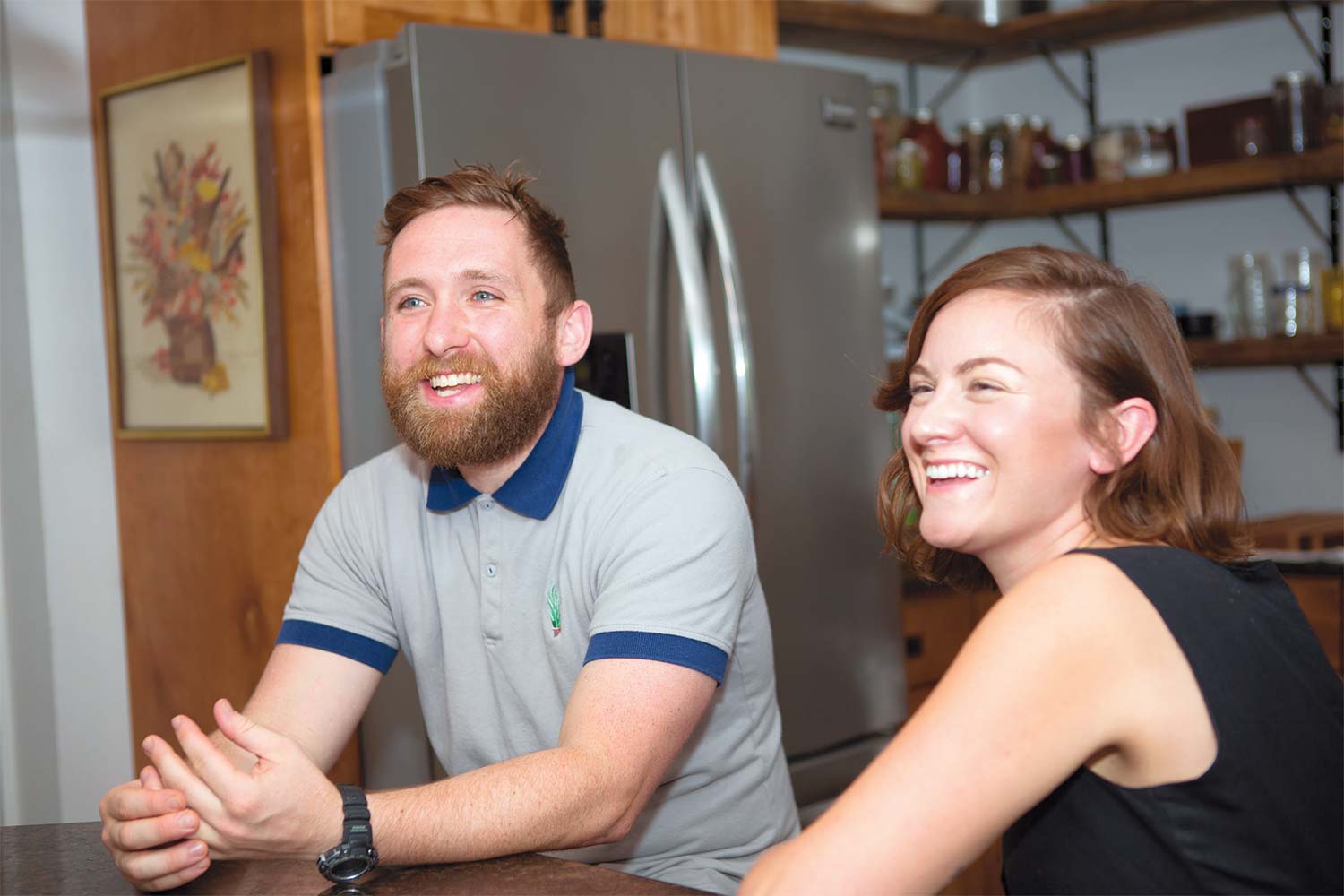
Danny and Katie Childs
“Working with small farms, there’s also
more of a chance to tell a story.
You can make their plants reach a lot of people.”
What Jersey ingredients are naturals in the glass?
DC: Our spring amaro was mostly from people’s backyards. There’s honeysuckle from ours, yarrow from Todd’s. Julie brought in peppermint and Josh Lawler brought anise hyssop. They’re not necessarily wild, or hyperlocal, but that entire amaro was from New Jersey. Katie and I want our yard to be our little cocktail pharmacy.
Any favorite creations?
DC: The Pinelands Old-Fashioned. It’s foraged berries, with Laird’s [applejack] and a pine tincture. I’ve always been super connected to the Pines. My grandfather is an explorer of them. But I love our brunch cocktail menu. I love the sodas: the celery, carrot-ginger and grapefruit tepache.
What’s on deck for fall?
DC: With amari, you’re always one season behind. We use Devil’s Springs Vodka—it’s 151-proof from Jersey. But in the fall, I want to use Laird’s bonded and go old-Jersey applejacker style. Amari are like the Wild West: ever-shifting. I want to look at even more of that from a hyperlocal lens. Can trade-outs be made without losing something? I also want to get more into preservation and the savory side of things: of fermentation and pickling in cocktails.
How can people navigate complicated cocktail menus?
DC: Do you like something sour? A stiff drink? A fizzy drink? An adventurous drink? Do you like shrubs? If you don’t know, ask. I can sift through a cocktail menu pretty well, but I still interact. The most important part of bartending is the human element.
What is the story behind the figurines?
DC: My grandfather Bruce bought these on the side of the road in the Pine Barrens. He has a wood-burning stove, and each year it’s a family tradition that we go over there to help him split wood. One year I chipped in extra hard, and at Christmastime he gave me the two figurines. I remember when he got them, when I was a kid. I was like, “These are so cool,” and he was so fascinated by them. He was the first person to help me start a garden, and he taught me to compost. He would take me fishing. He was very much a father figure.
Do you connect your pre-med and anthropology studies to your work today?
DC: It’s a love of plants and science. It’s part chemistry, part biology and part anthropology. It has been a continuous path.
What were some major insights from your travels?
DC: One of the first bittering agents ever used was cinchona, a bark from Peru. It is very medicinal, and that’s what a lot of alcohol is, in its origins. I brought all of those herbs back and studied them for microbial properties in the lab for three years and wrote a 250-page thesis. It was an intense form of geeking out on every part of these cultures. That experience shaped me.
What else did you learn on the road?
DC: South America was the first place I encountered amari. If you want to know the most prized thing I own, alcohol-wise, it’s this bottle of Araucano amaro from Chile. I studied the medicinal plants of the Mapuche, who have a long, rich history there. They’re involved in making some of the medicinal plants used in it—and that’s one of the old, famous Machuche chiefs in the top-left corner of the bottle. It was made by a German immigrant to Chile, and the only people who drink this now are the old-timers.
Did tent living change your perspective?
DC: We moved in in September and moved out in May, and it was the coldest winter in 40 years or something. The first two months we were cooking on the fire a lot. Then we got a big wood-burning camp stove, which basically kept us alive.
KC: I said, I think we can do this. Everything needs to be tidy and simplified. But we can make a home anywhere we go.
Do you value simplicity more now?
KC: It’s having one thing that you love so much.
Does beauty change the experience of cooking?
KC: I think it does. Creating an experience not only for each other, but when family comes over. We always come back to everything being really practical. With florals, too, keeping yourself inspired is about diving into that super-seasonal realm, collecting the things you find beautiful. In the Pine Barrens, right when it’s supposed to get really cold out, all of the ferns go completely gold. It’s amazing.
How do your worlds align in the kitchen?
DC: We only have time to cook together two days a week, so we try, on at least one of them, to really cook. Other days, I have been trying to preserve more—to “put em’ up,” as they say.
KC: When he goes and talks to farmers, he’s always keeping me in mind for projects or arrangements I’m doing, like plants that have bolted. It’s nice for those to meld together. Our worlds line up in different ways.
Favorite things to put up?
DC: I’m really excited about the fermented long-hot sauce I’m doing now . . .
How did your cooking journeys differ?
KC: I was brought upon some different food, I would say. Like eating the gizzards and the neck on Thanksgiving, very PA Dutch. I grew up cooking with my mom in Hanover, PA. She has always canned: pickles and peaches and tomato sauce. I love having them around aesthetically—the beauty of the jars, having them collected and gathered and effortless.
DC: And functional. That’s a cool way that we intersect: Katie’s very design-oriented. But to look up at the shelves and say, “We’re going to eat those.” or “We’re going to give those to our families as gifts.”
What about you, Danny?
DC: My mom and I lived with my grandmom Veronica, and I’d hang out with my grandmom when she cooked. She would give me this mix of coffee and milk that she called dodo. I’m mostly Irish, but she’s the part of my family that has German heritage. She’d always make pierogi and sausage. She would get together with her girlfriends and make sauerkraut at the end of the summer every year. Fast-forward to being with my uncle Craig, and seeing him obsess over organic. He moved all over, and I would travel to visit him from a young age. Boulder, Colorado. Asheville, North Carolina. He had a big garden and farm in Asheville. I remember him giving me kombucha at age 16.
What have you learned from Katie’s family?
DC: I remember the first time her mom told me what hog maw was, stuffed pig stomach. I had never had an experience like that growing up. The tradition that they have, the fact that it’s intact and tangible. You can talk to other people from that part of the state and they have the same cooking habits.
What are your go-to ingredients?
DC: We’re trying to do whole spices, to toast them and grind them. Hopefully we’ll be able to stop buying some of those things and fill the bottles ourselves. I’m pretty strict about seasonality. It causes you to really stop on that first bite of corn in the summer—we would have been waiting 10 months for it. It’s so worth it.
KC: It causes creativity because you have to find different ways of navigating through.
What cookbooks are you digging of late?
DC: Salt Fat Acid Heat by Samin Nosrat: I’ve read 50 pages, and I can’t wait to read the whole thing. Did you see the Michael Pollan documentary, Cooked? She was his cooking mentor. She’s a really good personality—a younger person, and very enthused about food.
THE FARM AND FISHERMAN TAVERN & MARKET
1442 Marlton Pike East, Cherry Hill
fandftavern.com
This fall, Childs is launching a new Instagram handle, @slowdrinks. Follow along to track his latest experiments behind the bar at Farm and Fisherman and beyond.
Drink Talk with Chef Todd Fuller
What’s striking about cocktails in 2017?
The cocktail world is getting kind of crowded, and that’s not a bad thing. You can go almost anywhere in the United States, and with a little bit of research, you can find a place to get a great drink. I don’t think you could do that—in fact, I know you couldn’t do that—three years ago, let alone 10.
What excites you about your cocktail program?
The most rewarding part of all of this is the evolution of our drink program in congruence with the food. We strive, as a kitchen, to use seasonal and local products in good ways. Really, I just set out to make good, balanced drinks that were properly made, whether it was a margarita with real juice or a Manhattan that’s stirred instead of shaken. It’s not for the sake of being unique, but for the sake of having something that’s aligned with our basic principles. It’s for the same end, to make a great drink.
What’s next?
We’re to the point where we have a secondary canning, just to have things through the winter. We’ve stepped that up a bit. Now, it’s ”What can we do to have things for drinks through the winter: peach preserves, raspberry preserves, blueberries.“ And the goal of all of this is to eventually use it. For me, it’s keep moving forward.



